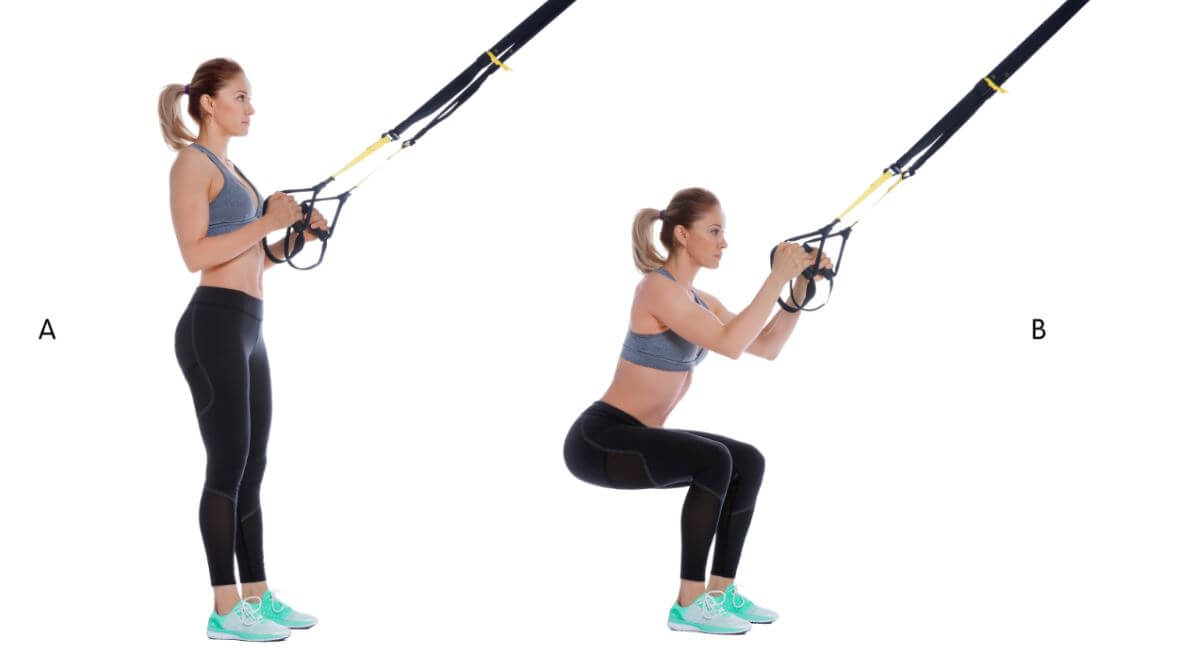How to Perform Suspension Training?

Every day there are more and more athletes who want to perform suspension training. Suspension training is also known as TRX. Athletes are turning to TRX in order to take advantage of the numerous benefits that the exercises provide. That’s why we’ve decided to prepare this article to share all you need to know about suspension training.
The concept of suspension training is quite basic: it employs the use of two adjustable straps that are used to partially suspend the body. Your body’s own weight will be used as resistance in order to work out different muscle groups.
Every movement that you perform in suspension training requires the integration of mobility, stability, strength, balance, and coordination. That’s why, in addition to being fun, it’s a form of exercise that provides numerous benefits.
Among other things, when you perform suspension training it works the whole body. There are different exercises to allow you to work out different muscle groups. The straps will also allow you to improve stability and balance, allowing you to obtain amazing results.
Suspension training can be incorporated into your training routine. You can even dedicate one day a week to this type of training. The exercises can be performed in a gym, although since they are done in suspension, the difficulty is increased.
Challenge your body and perform suspension training
Suspension training has become an essential pillar in many gyms since it’s a way to challenge athletes. TRX is also a very effective way to burn fat, develop strength and perform cardio using only your own weight.
In most cases, suspension training consists of traditional and functional resistance exercises that are performed using the TRX system. Exercises can be carried out with adjustable straps which open the way for numerous variations.
TRX sessions also encourage your body to constantly work to maintain stability. Therefore, suspension training exercises help improve aspects such as coordination and balance. The closer your center of gravity is to the ground, the tougher these exercises will be.

In short, almost any exercise that you perform in suspension will be much more challenging than the traditional workout. If you’d like to start suspension training, have a look at the following exercises.
Suspension training exercises
Chest press suspension training
The first exercise we’ll share with you is the chest press. Unlike traditional push-ups, place your hands on the TRX grips and tilt your body forwards.
Once you are in that position, bring your chest towards the floor and support your weight with your arms. Try to perform as many repetitions as you can over 3 or 4 sets.

Inverted suspension rowing
Inverted rowing is an excellent way to strengthen your back and work out your abdomen. In order to perform this exercise, hold a strap in each hand and place your feet in front of the handles with your body lying directly in front of them.
Next, flex your abdomen, buttocks and use your pectoral muscles to pull upwards. The premise of the exercise is to bring your torso up to the straps. Try to perform as many repetitions as you can.

Suspension squats
You can also perform squats with TRX straps. In order to perform the exercise, stand in front of the straps and extend your arms in front of you forming a 90-degree angle. Keep your elbows by your sides and the handles at chest level.

Once in position, push your hips back, until your thighs are parallel to the ground. Then, push upwards to return to your starting position.
Before finalizing, it’s important to remember that in order to perform suspension training, you should be able to trust the adjustable straps to hold your body weight in order to maintain stability.
When you’re confident, increase the resistance and the number of repetitions you perform. Keep in mind that progress is individual and it depends on your own abilities and strength. Now, would you like to introduce suspension training into your exercise routine?
Every day there are more and more athletes who want to perform suspension training. Suspension training is also known as TRX. Athletes are turning to TRX in order to take advantage of the numerous benefits that the exercises provide. That’s why we’ve decided to prepare this article to share all you need to know about suspension training.
The concept of suspension training is quite basic: it employs the use of two adjustable straps that are used to partially suspend the body. Your body’s own weight will be used as resistance in order to work out different muscle groups.
Every movement that you perform in suspension training requires the integration of mobility, stability, strength, balance, and coordination. That’s why, in addition to being fun, it’s a form of exercise that provides numerous benefits.
Among other things, when you perform suspension training it works the whole body. There are different exercises to allow you to work out different muscle groups. The straps will also allow you to improve stability and balance, allowing you to obtain amazing results.
Suspension training can be incorporated into your training routine. You can even dedicate one day a week to this type of training. The exercises can be performed in a gym, although since they are done in suspension, the difficulty is increased.
Challenge your body and perform suspension training
Suspension training has become an essential pillar in many gyms since it’s a way to challenge athletes. TRX is also a very effective way to burn fat, develop strength and perform cardio using only your own weight.
In most cases, suspension training consists of traditional and functional resistance exercises that are performed using the TRX system. Exercises can be carried out with adjustable straps which open the way for numerous variations.
TRX sessions also encourage your body to constantly work to maintain stability. Therefore, suspension training exercises help improve aspects such as coordination and balance. The closer your center of gravity is to the ground, the tougher these exercises will be.

In short, almost any exercise that you perform in suspension will be much more challenging than the traditional workout. If you’d like to start suspension training, have a look at the following exercises.
Suspension training exercises
Chest press suspension training
The first exercise we’ll share with you is the chest press. Unlike traditional push-ups, place your hands on the TRX grips and tilt your body forwards.
Once you are in that position, bring your chest towards the floor and support your weight with your arms. Try to perform as many repetitions as you can over 3 or 4 sets.

Inverted suspension rowing
Inverted rowing is an excellent way to strengthen your back and work out your abdomen. In order to perform this exercise, hold a strap in each hand and place your feet in front of the handles with your body lying directly in front of them.
Next, flex your abdomen, buttocks and use your pectoral muscles to pull upwards. The premise of the exercise is to bring your torso up to the straps. Try to perform as many repetitions as you can.

Suspension squats
You can also perform squats with TRX straps. In order to perform the exercise, stand in front of the straps and extend your arms in front of you forming a 90-degree angle. Keep your elbows by your sides and the handles at chest level.

Once in position, push your hips back, until your thighs are parallel to the ground. Then, push upwards to return to your starting position.
Before finalizing, it’s important to remember that in order to perform suspension training, you should be able to trust the adjustable straps to hold your body weight in order to maintain stability.
When you’re confident, increase the resistance and the number of repetitions you perform. Keep in mind that progress is individual and it depends on your own abilities and strength. Now, would you like to introduce suspension training into your exercise routine?
All cited sources were thoroughly reviewed by our team to ensure their quality, reliability, currency, and validity. The bibliography of this article was considered reliable and of academic or scientific accuracy.
- Calatayud, J., Borreani, S., Colado, J. C., Martín, F. F., Rogers, M. E., Behm, D. G., & Andersen, L. L. (2014). Muscle activation during push-ups with different suspension training systems. Journal of Sports Science and Medicine, 13(3), 502–510. https://doi.org/10.1097/mco.0b013e328361c8b8
- Cugliari, G., & Boccia, G. (2017). Core Muscle Activation in Suspension Training Exercises. Journal of Human Kinetics, 56(1), 61–71. https://doi.org/10.1515/hukin-2017-0023
- Mok, N. W., Yeung, E. W., Cho, J. C., Hui, S. C., Liu, K. C., & Pang, C. H. (2015). Core muscle activity during suspension exercises. Journal of Science and Medicine in Sport, 18(2), 189–194. https://doi.org/10.1016/j.jsams.2014.01.002
- Emara, H. A., El-Gohary, T. M., & Al-Johany, A. A. (2016). Effect of body-weight suspension training versus treadmill training on gross motor abilities of children with spastic diplegic cerebral palsy. European Journal of Physical and Rehabilitation Medicine, 52(3), 356‐363. Retrieved from https://www.cochranelibrary.com/central/doi/10.1002/central/CN-01380025/full
This text is provided for informational purposes only and does not replace consultation with a professional. If in doubt, consult your specialist.








